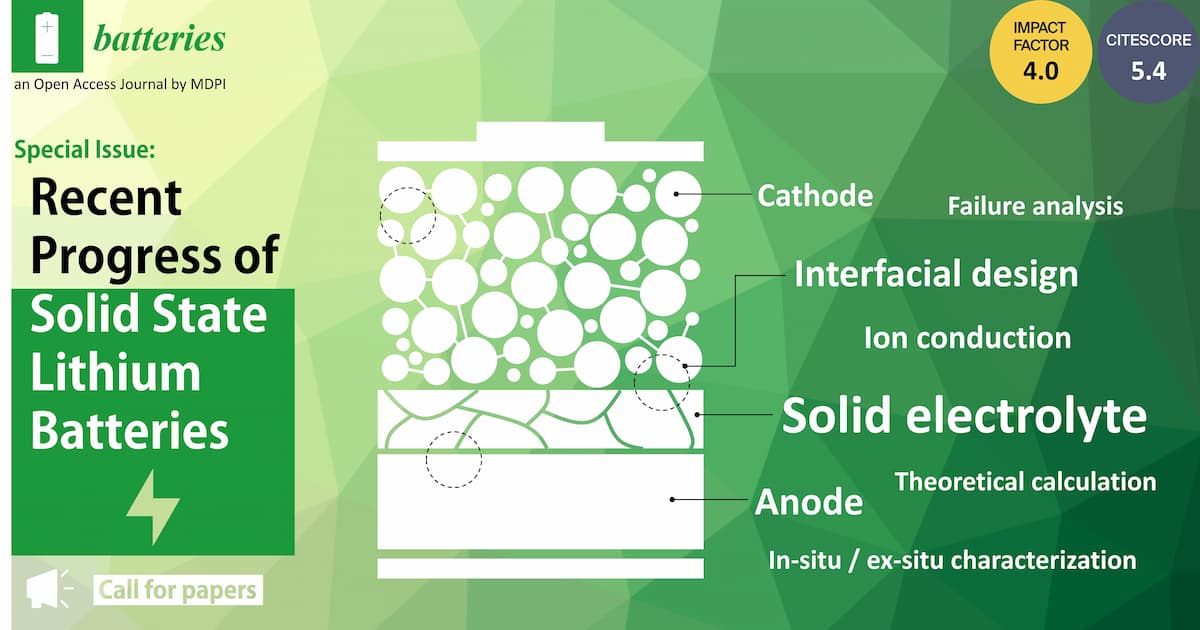Recent Process of Solid State Lithium Batteries
A special issue of Batteries (ISSN 2313-0105). This special issue belongs to the section "Battery Materials and Interfaces: Anode, Cathode, Separators and Electrolytes or Others".
Deadline for manuscript submissions: closed (31 May 2024) | Viewed by 2644

Special Issue Editor
Interests: solid-state batteries; solid-state electrolytes; lithium-sulfur batteries; atomic/molecular layer deposition; advanced battery materials; advanced characterization
Special Issue Information
Dear Colleagues,
Solid-state lithium batteries (SSLBs) are a promising technology for next-generation energy storage, showing potentials of high safety, high energy density, long cycle life, and fast-charging capability. Research over recent decades has led to substantial progress in the development of solid-state electrolytes (e.g., sulfides, oxides, halides, solid polymers, etc.) and encouraging results of pairing high-voltage/high-capacity cathodes with lithium metal anodes. Further improving the SSLBs performance and eventually transferring the technology to the commercial market, however, require deeper understanding of the fundamental science, new materials discovery, and innovative engineering solutions. Therefore, interdisciplinary research and collaborative work across academia and industry are indispensable to fulfill the promise of SSLBs technology.
This Special Issue aims to cover the latest progress of solid-state lithium batteries. Original research articles, reviews, and perspectives with relevant topics are highly welcome.
Potential topics include but are not limited to:
- Solid-state electrolytes;
- Electrode materials for all-solid-state batteries;
- Interfacial designs and engineering;
- Mechanistic study of ion conduction in solids;
- Advanced in situ / ex situ characterization tools;
- Safety and failure mode analyses;
- Theoretical calculations and simulation for solid-state battery materials.
Dr. Jing (Erica) Luo
Guest Editor
Manuscript Submission Information
Manuscripts should be submitted online at www.mdpi.com by registering and logging in to this website. Once you are registered, click here to go to the submission form. Manuscripts can be submitted until the deadline. All submissions that pass pre-check are peer-reviewed. Accepted papers will be published continuously in the journal (as soon as accepted) and will be listed together on the special issue website. Research articles, review articles as well as short communications are invited. For planned papers, a title and short abstract (about 100 words) can be sent to the Editorial Office for announcement on this website.
Submitted manuscripts should not have been published previously, nor be under consideration for publication elsewhere (except conference proceedings papers). All manuscripts are thoroughly refereed through a single-blind peer-review process. A guide for authors and other relevant information for submission of manuscripts is available on the Instructions for Authors page. Batteries is an international peer-reviewed open access monthly journal published by MDPI.
Please visit the Instructions for Authors page before submitting a manuscript. The Article Processing Charge (APC) for publication in this open access journal is 2700 CHF (Swiss Francs). Submitted papers should be well formatted and use good English. Authors may use MDPI's English editing service prior to publication or during author revisions.
Keywords
- solid-state batteries
- solid electrolytes
- interface
- lithium metal anodes
- high-performance electrodes
- ion conduction mechanism
- high energy density
Benefits of Publishing in a Special Issue
- Ease of navigation: Grouping papers by topic helps scholars navigate broad scope journals more efficiently.
- Greater discoverability: Special Issues support the reach and impact of scientific research. Articles in Special Issues are more discoverable and cited more frequently.
- Expansion of research network: Special Issues facilitate connections among authors, fostering scientific collaborations.
- External promotion: Articles in Special Issues are often promoted through the journal's social media, increasing their visibility.
- Reprint: MDPI Books provides the opportunity to republish successful Special Issues in book format, both online and in print.
Further information on MDPI's Special Issue policies can be found here.





